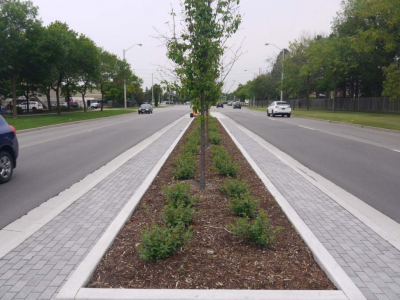Difference between revisions of "Stormwater Tree Trenches: Maintenance"
Jump to navigation
Jump to search

Dean Young (talk | contribs) |
|||
| Line 19: | Line 19: | ||
For more detailed guidance, refer to STEP's [https://sustainabletechnologies.ca/app/uploads/2016/08/LID-IM-Guide-2016-1.pdf Low Impact Development Stormwater Management Practice Inspection and Maintenance Guide] and City of Toronto's [https://www.toronto.ca/services-payments/building-construction/infrastructure-city-construction/construction-standards-permits/standards-for-designing-and-constructing-city-infrastructure/construction-specifications-drawings-for-green-infrastructure/ Construction Specifications and Drawings for Green Infrastructure] documents.<ref> Toronto and Region Conservation Authority. 2016. Low Impact Development Stormwater Management Practice Inspection and Maintenance Guide. https://sustainabletechnologies.ca/app/uploads/2016/08/LID-IM-Guide-2016-1.pdf</ref> <ref> City of Toronto. 2021. Construction Specifications and Drawings for Green Infrastructure. https://www.toronto.ca/services-payments/building-construction/infrastructure-city-construction/construction-standards-permits/standards-for-designing-and-constructing-city-infrastructure/construction-specifications-drawings-for-green-infrastructure/</ref> | For more detailed guidance, refer to STEP's [https://sustainabletechnologies.ca/app/uploads/2016/08/LID-IM-Guide-2016-1.pdf Low Impact Development Stormwater Management Practice Inspection and Maintenance Guide] and City of Toronto's [https://www.toronto.ca/services-payments/building-construction/infrastructure-city-construction/construction-standards-permits/standards-for-designing-and-constructing-city-infrastructure/construction-specifications-drawings-for-green-infrastructure/ Construction Specifications and Drawings for Green Infrastructure] documents.<ref> Toronto and Region Conservation Authority. 2016. Low Impact Development Stormwater Management Practice Inspection and Maintenance Guide. https://sustainabletechnologies.ca/app/uploads/2016/08/LID-IM-Guide-2016-1.pdf</ref> <ref> City of Toronto. 2021. Construction Specifications and Drawings for Green Infrastructure. https://www.toronto.ca/services-payments/building-construction/infrastructure-city-construction/construction-standards-permits/standards-for-designing-and-constructing-city-infrastructure/construction-specifications-drawings-for-green-infrastructure/</ref> | ||
| + | |||
| + | ==References== | ||
Revision as of 20:41, 5 October 2022
The following maintenance procedures and preventative measures should be incorporated into a maintenance plan:

An example of a stormwater tree trench system located within the existing street median, Mississauga, ON. Central Parkway retrofit. (Source: CVC, 2016).[1]
- Tree Maintenance: Inspection and maintenance of all municipally-owned trees shall be conducted by municipal staff or its contractors after the warranty period of the construction contract. This work may include, frequent watering and fertilizing as trees begin to establish themselves in the feature, this is especially important during drought-like conditions. Proper tree pruning is also important throughout the life of the tree, but especially during the early life stages of trees to help limit the potential for detrimental deformations or growth habits. This will help reduce costs as the tree matures and attempts at correcting improper growth, or replacement of the tree entirely becomes more costly. Staff involved in inspection and maintenance of these features should be experienced with the designated planting plan, plant species identification, and weed removal and control methodologies enacted by the municipality.
- Planting Beds: Remove invasive species and weeds, trash and organic debris. Ensure to refresh mulch to retain complete coverage and add mulch to correct grade inconsistencies in tree beds flush with the sidewalk (minimum depth of 50 mm to a maximum of 100 mm and an minimum of 40 mm from the base of the tree in the feature). To be completed every 3 - 6 months.
- Pavement / Covered Trenches: Maintain tree surroundings and grates and ensure that the grates themselves are level with the sidewalk, as needed. After 3 - 5 years, dependent upon tree growth, remove inner ring to allow tree to mature and grow unimpeded.
- Inlets: This may include trench drains, curb cuts/openings and pavement edges, all obstructions of trash and debris should be removed twice a year. Any plants within trench drains themselves or 100mm of the entrance or exit of said drains shall be removed twice a year.
- Irrigation System: Maintenance or replacement of these system components shall take place as required, meanwhile winterizing watering systems to prevent damage shall take place twice a year (in the Spring and Fall). To limit excess salt impacts in the feature flushing and/or leaching excess sodium in the soil should be done annually in the spring by fully saturating the passive irrigation system with water.
- Soil / Growing Medium: Testing of soil to determine its structure, organic matter and confirm microbial level counts are satisfactory for selected vegetation will take place at installation and during performance diagnostic intervals. Whereas organic fertilizing and soil amendments recommended by testing will be done on an as-needed basis.
- Underdrain: Flush out accumulated sediment with a hose or for more intensive clogging a pressure washer, done on an as-needed basis.
- Vegetation: Perform routine vegetation maintenance tasks (i.e., watering, weeding, trimming) at recommended frequencies (weekly or as required to maintain optimal soil moisture) over the two-year establishment period for the plantings; and replace plants that don't survive the initial establishment period (assumes 10% and 20% of plant material does not survive the first year for Minimum Recommended and High Frequency maintenance scenarios, respectively). Replacement of dead/diseased plants once established shall take place every 6 months or yearly dependent upon the minimum of 80% vegetation coverage. Remove any undesirable vegetation (invasive, seedlings etc.) every 3 - 6 months, and ensure proper pruning, cut back and thinning of shrubs and plants every year.
For more detailed guidance, refer to STEP's Low Impact Development Stormwater Management Practice Inspection and Maintenance Guide and City of Toronto's Construction Specifications and Drawings for Green Infrastructure documents.[2] [3]
References[edit]
- ↑ Credit Valley Conservation. 2016. Central Parkway Low Impact Development Infrastructure Performance and Risk Assessment. May 2016. https://cvc.ca/wp-content/uploads//2021/07/TechReport_CPW_Final.pdf
- ↑ Toronto and Region Conservation Authority. 2016. Low Impact Development Stormwater Management Practice Inspection and Maintenance Guide. https://sustainabletechnologies.ca/app/uploads/2016/08/LID-IM-Guide-2016-1.pdf
- ↑ City of Toronto. 2021. Construction Specifications and Drawings for Green Infrastructure. https://www.toronto.ca/services-payments/building-construction/infrastructure-city-construction/construction-standards-permits/standards-for-designing-and-constructing-city-infrastructure/construction-specifications-drawings-for-green-infrastructure/